In the first article of this Writing Reiki series, guest blogger Reiki master Colin Powell shared historical background on writing the Japanese language. In Part 2, he unlocks the deeper meaning of the term Reiki. Understanding the Japanese translation of Reiki helps us retrieve what has been lost in contemporary translations.
WRITING REIKI, PART 2: Understanding the Japanese Translation of Reiki
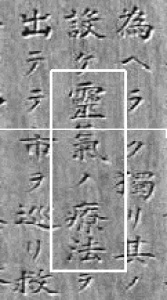 If we look at Usui’s Memorial Stone (at right) or early Reiki certificates from the 1930s, we see the phrase Reiki Ryoho written in the original kanji characters. This is how Mikao Usui and Chujiro Hayashi would have written it. Some of the more traditional Japanese styles of Reiki are now using the original kanji, or at least teaching about it.
If we look at Usui’s Memorial Stone (at right) or early Reiki certificates from the 1930s, we see the phrase Reiki Ryoho written in the original kanji characters. This is how Mikao Usui and Chujiro Hayashi would have written it. Some of the more traditional Japanese styles of Reiki are now using the original kanji, or at least teaching about it.
There is, however, some reluctance to use the original Reiki kanji in publicity material in Japan because, although the memory of Usui Reiki Ryoho all but disappeared after World War 2, an awareness of Reiki has resurfaced in an unusual way. Many Japanese people, especially the younger generations, have become aware of Reiki through popular entertainment.
Lions and tigers and ghosts, oh my!
Japanese anime films and manga comics portray Reiki as a magical force or a sword of great power, even though the actual kanji used is different. Between that popular misrepresentation of Reiki and a meaning of the original Reiki kanji that carries connotations of spirits, ghosts and psychic phenomena, Reiki teachers in Japan have to be careful not to give potential students the wrong impression about Usui Reiki Ryoho.
That brings us to the question, what does the original kanji for Reiki actually mean in regard to the practice of Usui Reiki Ryoho?
Reiki kanji meaning
In the kanji for rei (see below), we see the canopy of heaven from which four drops of rain (ame) are falling into three containers or mouths (kuchi). The symbolism of water is very significant spiritually in that it is endlessly adaptable. Water is responsive, changes form, and flows easily around obstacles, but when necessary, water also has the capacity to slowly dissolve obstacles and carry them along.
Below the rain and containers, a shaman, usually a female (miko), stands on the earth, arms outstretched and tassels hanging down.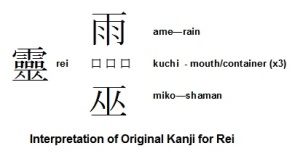
Chinese roots of the Reiki kanji
As mentioned in Part 1 of this article, the Japanese kanji are actually derived from Chinese characters. If we look at the earlier, Chinese interpretation of this character, pronounced ling in Chinese, (see below) this is sometimes broken down into just two parts: drops of rain (also pronounced ling), in which the mouths are interpreted as large raindrops,1 and a shaman, witch or sorcerer, pronounced wu in Chinese.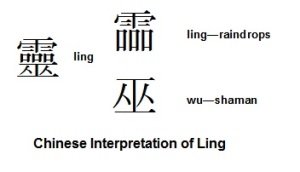
We can even break down the character wu further (see below), into the work (gong) of two people (ren written twice). If we look at a still earlier version, for example in a seal script,* we can see that the work the two people are doing is praying or dancing. Further, the two people shown are mirror images and may represent that it is necessary for the shaman to balance her dual human nature (spiritual and material) in order to perform the work of praying for rain.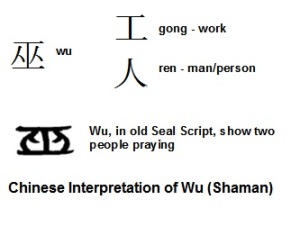
The kanji for ki (see below) consists of the radical, kome or rice, surrounded by a vapour or steam (also pronounced ki), representing the steam given off when rice is cooking in a pot.2 The character for ki was originally written as three wavy lines, which symbolised air or breath3 – ki being something that could not be seen but could cause change and be felt.4 We see that there was originally a sense of ki being more like an invisible vapour or atmosphere that could be felt, or the breath of life, rather than being life force energy.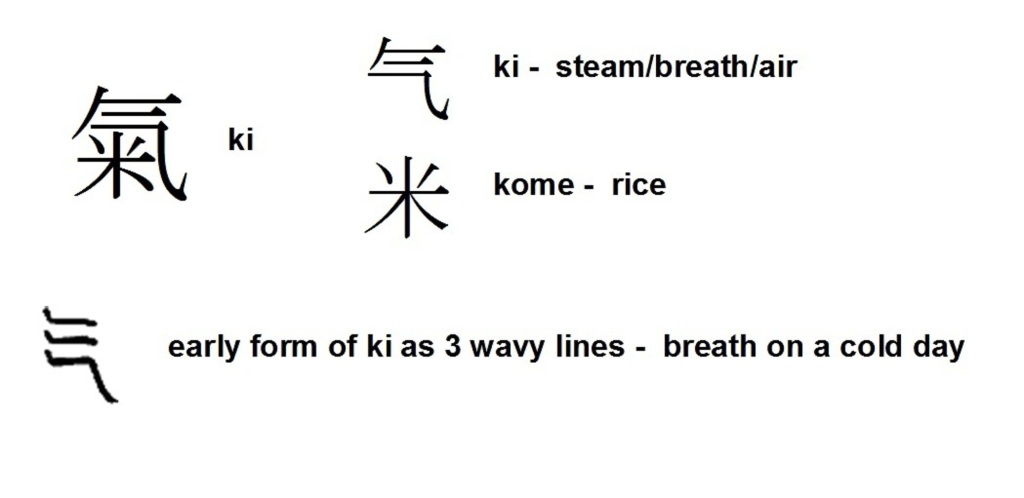
Reiki trinity
Putting this symbolism together, we have a representation of the trinity found in many diverse spiritual traditions: Heaven, Earth and Man, known as Ten-Chi-Jin in Japan.
In the kanji for rei, which on its own means spirit, soul, ghost, divine, sacred, the rain symbolises life-giving energy from heaven in the form of water, collected in the three containers or mouths where it can directly revitalise mind, body and spirit.
The shaman acts as an intermediary between heaven above and the earth below, where the energy-giving rice grows and provides mankind with sustenance and energy from the earth. Thus, the heaven energy combines with the earth energy in the heart of the shaman, allowing her to become fully balanced as a unity and realise her true nature.
This is the spiritual essence of Reiki practice: the Reiki practitioner or teacher, through Reiki practice, balances her own mind and body (or spiritual and material aspects), just as the shaman does.
Reiki kanji today
If we look at the modern kanji for Reiki (see below), much of this rich symbolism is lost. There are no containers or mouths to hold the rain from heaven, and no shaman. The rice grains, which in the original kanji give an impression of radiance, have been replaced with what looks like a dagger or an X, which implies cutting off or cancelling the energy from the earth, symbolised by steam.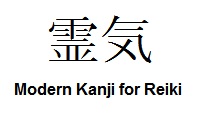
If more Reiki teachers taught the deeper symbolism and meaning of the Reiki kanji, students would start with a greater understanding of Reiki practice, leading to a more profound experience for teacher, practitioner and client. The system of Usui Reiki Ryoho is much more than a hands-on complementary therapy.
How do you think we might best write the term Reiki in our publicity material, according to the original or the modern kanji? Please share your thoughts about the Japanese translation of Reiki in a comment below
*Seal script, or more correctly in this case, small seal script, is even older than the usual kanji (Chinese: hanzi) used today. It developed from characters carved on bronze objects (which in turn developed from etchings on oracle bones), and dates from around the 3rd Century BC. Since the characters were etched onto metal, they tended to be quite simple and fairly angular. Nonetheless, seal script often manages to capture an element of flow, and sometimes includes curves. Eventually the script became used on seals (chops, stamps or signets) as a way of signing or sealing official documents or works of art, which is where derivatives of seal script can be seen today, as a rectangular or circular stamp, usually in red ink.
References:
1. https://www.chineseetymology.org/CharacterEtymology.aspx?characterInput=%E9%9C%9D
2. https://www.mts.net/~bodnaryk/KanjiListOnline.html
4. https://damo-qigong.net/qi-theory.htm
Thank you to Paul Selk for his support with resources and fact-checking.
AS A SPECIAL GIFT Here is a pdf version of the entire article, “WRITING REIKI: The Evolution of the Term Reiki in the Japanese Language,” which you’re welcome to print for your personal use or to help your Reiki students understand the Japanese translation of Reiki with more nuance. You are also welcome to link to the pdf on this blog, but you do not have permission to post the pdf online or to publish it in print.
L’evoluzione del termine REIKI nel linguaggio giapponese is an Italian translation of this article you can print and share as is, without copying or changing the content or presentation in any way.
Escrever Reiki a Evolução da Palavra Reiki no Língua Japonesa is a Portuguese translation of this article, What Does the Reiki Kanji Really Mean, and Writing Reiki that you can print and share as is, without copying or changing the content or presentation in any way. Please do not email or post it on your website, but you are welcome to post a link to the article here. Thank you for your support.
RELATED READING that addresses the complexity of Japanese translation of Reiki:
Writing Reiki (Part 1)
Reiki Is Not a Word
_______________
Want to be informed of more articles like this? Join my email list here!

Dear Pamela Miles, You can’t imagine how your article and your beautiful work in general give me more confidence and positive vibes. With your own permission, I have a request to make. Please, let me traduce this incredible text in French. My students and French practionners could be very interested by this wonderful work. But they need a french version.
Don’t hesitate to contact me, in english by my personnal email. Feel free to think about my idea.
Paul Marchal
Thank you for your interest, Marchal. I appreciate it when people offer to translate articles into other languages. We have only a couple of French translations.
I’ll follow up soon through email, or reach out using the Contact form.
And meanwhile, did you see Part One of this series, Writing Reiki?
Hi Daniel and Pamela
As far as I know, there is no evidence that Mikao Usui did not want his Reiki system to leave Japan. In the Kokai Denju (Thoughts on the Teachings) section of the handbook (or Hikkei) of the Usui Reiki Ryoho Gakkai, Usui Sensei states: “Our Reiki Ryoho is a creative idea, which no one has developed before and there is nothing like this in this world. Therefore I am going to open this idea to anybody for the benefit and welfare of all. ”
However, when it comes to Chujiro Hayashi, then he was certainly against Reiki Ryoho leaving Japan… initially. On one of the tapes I have of Hawayo Takata telling the story of how she first heard about Reiki at Chujiro Hayashi’s clinic, she says that he did not want to teach her because she was not Japanese and that Reiki was “only for Japanese”. It took a lot of repeated asking and, finally, a letter to Chujiro Hayashi from Takata’s surgeon, Dr Maeda, to help him change his mind – and thank goodness he did! 🙂
Thank you, Colin.
I am, however, shy to use the word “certainly” based on tapes of Mrs. Takata’s teaching, since she used story-telling to teach in the traditional way, rather than as history. And even if Hayashi-sensei said that to her, it might have been to develop her understanding rather than as a blanket statement. Or perhaps it was a political statement to reassure his Japanese students.
There are always so many considerations going into a spoken account, especially of a conversation that happened long ago. This is why it is useful to come up with published material whenever possible. Although that can (and usually does) have a slant of its own, people are more careful when they put something in writing.
There is so much we will never know about the history of Reiki practice.
Hi Pamela
Yes, Takata was a great storyteller. How about I rephrase that sentence as: “However, when it comes to Chujiro Hayashi, according to one of the tapes I have of Hawayo Takata telling the story of how she first heard about Reiki at Chujiro Hayashi’s clinic, she says that he did not want to teach her because she was not Japanese and that Reiki was “only for Japanese”.
🙂
Thank you, Colin. That is a perfectly acceptable, credible way to put it. 🙂
Hi Colin,
I remember a rumour (though can’t immediately connect to the source) that it was Chujiro Hayashi’s common practice: whenever a new student came, he was turned away with some polite reason but without any hope for decision reversing and further acceptance (and may be other traditional masters also acted that way). If the potential student had enough will to study, he would come back after some time and then will be turned away again. Only after asking three times, without any evident hope, and thus proving his determination, would that student be accepted.
I believe that what happened to Hayashi and Takata – he told her what he was convinced in – that Reiki is only for Japanese and that it’s not for women (at least mastery). But when she eventually humbly came back and asked to study for the third time (without even knowning that it’s a kind of exam to pass), he concluded that despite his views accepting her as a student was something that had to be done.
Of course, I may be wrong in that, and even if such an “exam” tradition ever existed, it was not meant to be published or even to get known…
Hi Daniel
I have heard that “rumour” in the context of a “rule of thumb” for asking a person if they would like a Reiki session. Asking three times gives them the opportunity to think about what may originally have been a reflex decision to say “no” and to maybe find out more about it and allay any fears or misunderstandings they might have.
As for women and Reiki Mastery, Chujiro Hayashi had no problem with women as Reiki Shihan (or teachers – there were no Reiki Masters in Japan 🙂 ). Chujiro Hayashi’s wife, Chie, was a Reiki Shihan and he also gave his blessing for Wasaburo Sugano to initiate Chiyoko Yamaguchi as a Shihan. Wasaburo’s wife, Chiyo, was also a Shihan.
(Source: Light on the Origins of Reiki by Tadao Yamaguchi)
I have not heard that “rumor” but appreciate anything undocumented being labeled as such.
Daniel, while it’s very true that there are profound differences between Japan and European-based cultures, I don’t agree with your statements about Reiki masters and intention or your assertions about what is common knowledge about Reiki.
We can support the credibility of Reiki practice by being mindful to separate fact from story and opinion, and avoid drawing conclusions without evidence to support them.
Hi Pamela,
Thank you very much for clear and thorough explanation of traditional writing of Reiki. I can immediately sense that it bears true meaning of Reiki, while modern writing is more like language meaning, explanation ancient sense to modern Japanese. So supposedly the choice of writing should be obvious in favor of traditional; but then very quickly I realized that it is not.
Unlike letter writing systems in Western languages that correspond to semantical sense of words in language, Kanji writing system corresponds more to inner, existantional sense. It has more sense of being, not just meaning. And we have to consider Kanji writing of Reiki together with events through which they came to the world.
As Yuko already drew, the modern writing of Reiki is connected to events of World War II and consequent mutual influence of American and Japanese cultures. Americans wished to influence Japanese, and Reiki was spread around the world by ethnical Japanese of American origin. That’s what “American-influcenced” Reiki writing means – Japanese healing system shared with the world and mutual influence.
Should there be only traditional Reiki writing, I believe that Reiki would have never leave Japan. Mikao Usui was a very traditional person and a kind of a chauvinist as we could call nowadays. He would never let his Reiki system outside Japan, and indeed it didn’t leave Japan during his lifetime. In particular, should there be only a traditional Reiki writing, non-Japanese would never have a chance to learn Reiki. That was Dr. Usui’s intention that his writing of Reiki carried in it. And indeed, it was not until the writing of Reiki was changed due to American influence that Reiki started to actively spread all over the world.
So in general, there currently exist at least two Reiki traditions stemmed from Mikao Usui. I believe that it is more correct for traditional Japanese branch to utilize traditional writing and for Western branch that descends from Hawayo Takata to use modern writing. Understanding traditional writing is not just a matter of symbolism, you have to have a Japanese spirit to understand it really. The shamans in the Kanji are not just shamans, they are Japanese shamans.
And in particulay I think that eventually every master will grow up his own understanding and writing. It may be somehow combining traditional and modern writings – it’s not a secret that many masters who got introduced to Reiki through Western “branch” had a great deal with Japan in their past incarnations. I believe that Reiki is whole, it’s not dividable into just two possible writings, and that there’s one writing the most suitable for a particular person. For example, I never thought of importance of Reiki Kanji choice, but now that I think of it – personally for me it looks right to write “Rei” as in traditional writing and “Ki” as in modern writing.
Daniel, I am curious on what basis you have decided that Mikao Usui would not have let his Reiki system leave Japan.
Although Usui-sensei might seem traditional by today’s standards, it seems he was quite forward-thinking in his day, as evidenced by his choice to make his system widely available rather than keeping it for a select few, as was usual in his day, and the personal effort he made to do so.
As I understand it, by the time Usui-sensei was teaching, the Japanese had seen various aspects of their culture adopted by westerners, and they were not pleased with the lack of understanding with which this was done.
That Reiki practice did not leave Japan during Usui’s lifetime may be simply because the opportunity did not present itself as it did to his student, Chujiro Hayashi, who brought the practice to Hawaii with his student, Hawayo Takata, a first generation Japanese-American and resident of Hawaii who came to his clinic in Japan.
Hi Paula,
my basis for belief of Mikao Usui not wanting Reiki outside Japan is based on the following common (hopefully) knowledge about Reiki and its cooperation with a Reiki master.
There is no such thing as lack of opportunity or bad circumstances that can possibly prevent a Reiki master from implementing his (her) intention. Master students are taught that, and it’s completely true in any area of life, and it’s especially true with what a master wants to do with Reiki. If we also consider that one’s intention is as strong as high is the price that persion is ready to pay for accomplishment, and remember that Mikao Usui was ready to continue all attempts to achieve Reiki until done, even if it would cost him life – we must conclude that his intention was extremely strong even compared to other masters. For such a person simply what he did is what he had intended.
Certainly Mikao Usui was not an agressive chauvinist; in fact I belive he didn’t even think whether let Reiki abroad or not. In that time many traditional Japanese still considered the world equals Japan. History of Reiki spread all over the world very closely correlates with spread of Japanese traditional Karate, and even by times. At first Karate was also a secret art; only at the beginning of XX century Gichin Funakoshi began spreading it all over Japan. His students continued, and some other masters (namely, Gogen Yamaguchi) input their share – before World War II still only in Japan. After WWII Karate started to spread all over the world – primarily by Oyama Masutatsu and Gogen Yamaguchi, followed by some Funakoshi students. But that was not before Yamaguchi almost committed a Seppuku – that was his feeling of disappointment of what happened to his motherland. That was the way many traditional Japanese felt. (And what stopped Yamaguchi was revelation that he got during the rutial meditation – that instead of wasting his life for nothing he can use it to teach his art all over the world. Again – all over the world, time has arrived).
I am telling all that and making a parallel between Reiki and Karate in attempt to describe that Japanese just have a different mind and spirit setup. A different sense of purpose of life, deeds, intention, consciousness for reincarnations. The differences are so deep that it always amazed me how Westerners could adopt Reiki and Karate and how Japanese could adopt Western style business, manufacturing, electronics and computing. But Reiki teaches that everything that exists does so rightfully, and that nothing in universe happens without sense or without reason.
I believe that differences in writing of Reiki reflect changes and what happened to the system in its spread over the world. And now as more and more becomes known about the tradition, it is open for each master to develop his (her) own sense of Reiki writing, in much the same way as every master eventually develops his/her own unique initiations style.
Thanks for this explanation and exploration, Pamela and Colin. Personally, I prefer the older, original Kanji. While I am the first to admit that language evolves over time, the older Kanji carries a more pleasing connection to a rich past. I love the description of the shaman, and would even go farther back to use the old seal script for “wu” to portray gratitude, devotion and humble recognition of and connection to Earth and Spirit. There is a sense of the sacred that speaks to me through these older kanji, which mirrors my personal appreciation for Reiki practice.
Hi Rose,
After World War 2, MacArthur(GHQ) made our govenment to make the Kanji easier … So the government made TOHYOH KANJI system based upon the US government’s order, even many Japanese people against that. Douglas MacArthur was planning to make us to use Alphabet in stead of Kanji in the future. The final goal was making us to use American English… To make us use Easier Kanji or New Kanji or Shin-jitai was just the beginning of the plan… But the US government gave up the plan later, anyway. The reason why the US government gave up the Plan was almost all Japanese people could read and write KANJI. The reason why the US government had an idea to force us using alphabet(the final goal was making us use American English as I told you.) was they thought most us were not able to read and write Kanji, because Kanji was too difficult for us… But the result of the Kanji exam surprised them and it
made them to give up the plan in the future… So our mother tongue is Japanese.
Traditionally our language is written in vertically, or written right to left. But after the the 2nd World War, the US government forced us to write Japanese from left to right for their future goal. Sadly,
that is the normal writing manner for our generation…
Anyway, when I was in elementary school the Tohyoh Kanji system or ???? was over. Suddenly JOHYOH KANJI system or ???? started because the US government complementary gave up the plan…
I remember I was comfused by the new name of the system…
Thanks of P.C., we started to meet the Kyu-jitai or old system Kanji more often. P.C. made to type old kaji much easier … But at least I do not know how to write Kyu-jitai.
My REIKI Sensei use Kyu-jitai. I think using Kyu-jitai teach us the meaning of the KANJI deeper. If I could write Kyu-jitai how cool.
I am named in Kyu-jitai but the government does not accept the name,
so officially I have to use new kanji…:(
This is the true stroy and I am not trying to offending American people.
I hope you understand my English…
Thank you, Yuko, for sharing the historical details about the changes to the kanji. I knew of several things that GHQ tried to influence in Japan but I hadn’t realised the potential impact they could also have had on your language!
Here in the West, we so often hear only one side of the story. I am glad that you managed to keep your own language and I hope that traditional Japanese culture may continue to survive and does not totally succumb to the Westernisation that, according to my Japanese Reiki Sensei, seems to be sweeping across the younger generation in Japan.
Thank you, Yuko, for sharing your story. Although I do agree with you that the kyujitai shares a deeper meaning than shinjitai, I respectfully submit that the plan to simplify the kanji was put into place by certain Japanese people many years before the Occupational Government.
Beginning in the Meiji era, many Japanese scholars wanted a reform of the written language due to the difficult nature of the kanji. At that time there were tens of thousands in use, and the difficulty of many is evident in the use of ruby letters (small kana written around the kanji) to let readers know how it was pronounced so they would know what the meaning was. This began with a push to begin using roman characters (romaji). The official romaji used today was originally developed in 1885 by Tanakadate as a means to encourage the disuse of kanji and to write the Japanese language entirely in roman characters. That is the Nihon-shiki romaji. Japan’s Cabinet, in 1937, announced that the Nihon-shiki romaji was the official way to write Japanese in roman characters. A more familiar form is the Hepburn romaji, which was popularized by J.C. Hepburn in his Japanese-English dictionaries (I have the 7th edition; 1908) beginning in 1886, I believe. This style is much more common. This should show a trend of attempts by some Japanese people themselves to do away with the kanji, including the recognition by the Cabinet in 1937. The GHQ DID want to push for use of romaji only, but the vote by various scholars picked simplification instead.
The simplification and ‘official list’ of the Kanji, although officially proscribed by the Occupational Government, was borne in the Taisho era, if not earlier. in 1922, the rinji kokugo chousakai (Temporary Japanese Language Research Committee – now part of Ministry of Cultural Affairs) selected a list of 1962 Kanji for “regular use”, with the intent of abolishing the rest. I am not able to access this book from the National Diet Library, but in a book from 1937 is a list of the Kanji for daily use, and simplified forms of many. The book, in Japanese, can be found here
https://iss.ndl.go.jp/books/R000000008-I000270021-00 most of the book is irrelevant, the part on Kanji starts on p19 (15/37 in the box). One can start reading by clicking any links below the first two, then navigate to the pages. The 1937 forms of the shinjitai can be found in the same book, here
https://kindai.ndl.go.jp/info:ndljp/pid/1455983/17
On the righthand page, second row from bottom, second kanji from left is the familiar rei kanji with the old form below it. Four rows above that and three kanji to the right is ki, almost in its modern form. This should show that both the toyo list and simplification should not be considered part of a move to eradicate the Japanese language, but a pre-World War II effort by the Japanese to make reading easier. Many of the simplified forms were taken from actual commonly used abbreviations of kanji used in handwriting…because they were too difficult to write.
Hi Rose
I believe the changes were made by the Japanese government in an effort to simplify the drawing of them and decrease the number of kanji that people had to learn at school.
Yes, the changes to the kanji used to write ‘Reiki’, without any thought or awareness of the deep meaning of them, is indeed a sad reflection of the loss of soul in the world generally and a loss of traditional cultural beliefs in Japan.
Sad, indeed!
As for which one to use–modern or original…I’d have to vote for the original. I think the modern simply does not represent the spirit of reiki.
Dear Colin and Pamela,
Marvelous, marvelous blog!
A question: I’m confused about the new kanji. How can they make the changes when it dramatically alters the interpretation?
I am so grateful for this article. I never knew how rich the original kanji was. It definitely deepens my appreciation.
On the other hand, the new kanji actually seems to mirror the growing loss of soul in the world today.
Thank you, Beth. How about heaping votes every day? 🙂
Please click here to vote for Reiki, Medicine & Self-Care as Best Reiki Facebook page
and click here to vote REIKI: A Comprehensive Guide Best Reiki Book.
You can vote every day through March 21, and I hope you will! Thanks so much for your support.
Wonderful reading Pamela. It is early morning in Australia I’m reading and drawing this Sacred Symbol as I drink my coffee. It ‘feels’ so right. Will introduce this in my teaching. I love the work you do and heap bouquets on you for it.
Thanks for your insightful comments, Silvio!
Taoism (Jp: Dokyo) was introduced into Japan from China, just as the hanzi (Jp: kanji) characters were. The trinity of Heaven Earth Mankind (Jp: Ten Chi Jin) which the Reiki kanji illustrate so well have permeated into many aspects of Japanese culture. As Pamela says, the original Reiki kanji provide an excellent vehicle for contemplation and doing so reveals many layers of correspondence and meaning.
Colin,
Thanks for sharing your researches! It is so important to have people as you and Pamela with whom we can share our thoughts and impressions! I am incline to think about Reiki as a contemplative practice too besides a hands on healing system. It is fascinating! Thanks again!
You’re very welcome, Silvio, and thank you for your comments. One of the benefits of the old kanji is that it reminds us to remain in a place of contemplating symbolism rather than coming up with answers.
Taoism was one of the major spiritual/philosophical streams in Japan during Usui’s life. I personally feel deeply connected to both systems, while I am clear that my practice is Reiki.
Hi Pamela,
I always preferred the old kanji than the modern. I always felt the old kanji had more to do with the philosophy of Reiki than the modern one.
But just when I read this post I had full comprehension of my feelings about it, I mean, I had lots of insights but I couldn’t translate it into words till I read this important post!
I could perceive a relation between the old kanji and the Tao System. Maybe I’m wrong but when we broke the character Wu into Gong and Ren we have Work (material or spiritual) and two People, maybe a Woman and a Man (Yin and Yang – the Tao – the opposite but complementary forces of the Universe that puts everything in motion). Maybe this couple is performing a fertility ritual or doing his daily work planting and harvesting the seeds (Rice) which will be later transformed, cooked to feed them and their sons… Maybe here it’s implicit the action of fire: the steam given off when rice is cooking is by action of fire over the pot in which there is rice into water. The elements alchemy, energy changes, isn’t life/ to live about changing? It made me think about the soul departing after death too. It reminds me that life is made of sacrifices, one thing has to die to give birth to another…
Thank you very much!